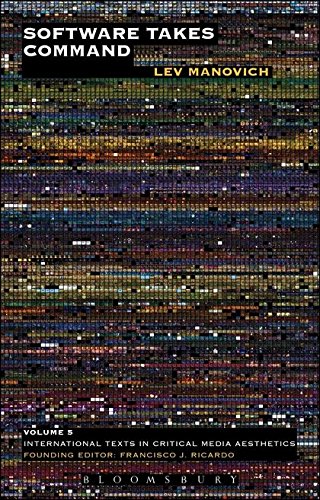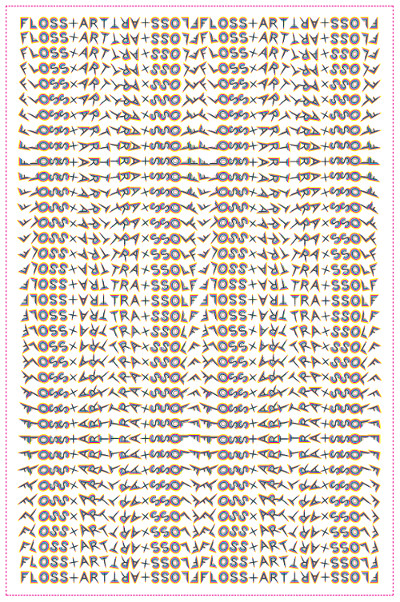Lev Manovich: Software Takes Command (2008–)
Filed under book | Tags: · aesthetics, computing, design, history of computing, media, media design, media theory, software, software studies

“Software has replaced a diverse array of physical, mechanical, and electronic technologies used before 21st century to create, store, distribute and interact with cultural artifacts. It has become our interface to the world, to others, to our memory and our imagination – a universal language through which the world speaks, and a universal engine on which the world runs. What electricity and combustion engine were to the early 20th century, software is to the early 21st century. Offering the the first theoretical and historical account of software for media authoring and its effects on the practice and the very concept of ‘media,’ the author of The Language of New Media (2001) develops his own theory for this rapidly-growing, always-changing field.
What was the thinking and motivations of people who in the 1960 and 1970s created concepts and practical techniques that underlie contemporary media software such as Photoshop, Illustrator, Maya, Final Cut and After Effects? How do their interfaces and tools shape the visual aesthetics of contemporary media and design? What happens to the idea of a ‘medium’ after previously media-specific tools have been simulated and extended in software? Is it still meaningful to talk about different mediums at all? Lev Manovich answers these questions and supports his theoretical arguments by detailed analysis of key media applications such as Photoshop and After Effects, popular web services such as Google Earth, and the projects in motion graphics, interactive environments, graphic design and architecture.”
First version self-published in 2008
Publisher Bloomsbury, July 2013
International Texts in Critical Media Aesthetics series, 5
Creative Commons Attribution Non-Commercial License
ISBN 1623567459, 9781623567453
xi+357 pages
Reviews: McKenzie Wark (Public Seminar, 2015), Alessandro Ludovico (Neural, 2014), Jussi Parikka (Cultural Politics, 2014), Patrick Davison (International Journal of Communication, 2014), Yanni Alexander Loukissas (Journal of Design History, 2014), Brock Craft (Popular Communication, 2014), Warren Buckland (New Review of Film and Television Studies, 2014), Martin E. Roth (Asiascape, 2014), Manuel Portela (MatLit, 2013), Alan Bilansky (Digital Humanities Quarterly, 2019).
Interviews: Michael Connor (Rhizome, 2013), Illya Szilak (HuffPost, 2017).
PDF (2 MB, added on 2019-8-23)
EPUB (7 MB, added on 2019-8-23)
Issuu (added on 2013-9-1)
Aymeric Mansoux, Marloes de Valk (eds.): FLOSS+Art (2008)
Filed under book | Tags: · art, code, collaboration, copyright, design, digital art, floss, free software, internet, open source, software, software art

What does Free and Open Source software (FLOSS) provide to artists and designers – beyond just free alternatives to established tools from Photoshop to Final Cut?
FLOSS+Art is the first book to answer this question. It shows how the value of Free Software lies in its differences and creative challenges, as opposed to out-of-the-box and off-the-shelf solutions; how it allows to work and collaborate differently with computers, and therefore enable different kinds of art and design.
The Internet – whose infrastructure is based on free software and open standards – is an obvious example of such an adaptable, collaborative artistic medium. FLOSS+Art also covers more traditional artistic domains such as graphic and audiovisual design, and how they shift from customer-centric to community-driven work.
FLOSS+Art critically reflects on the growing relationship between Free Software philosophy, open content and digital art. It provides first-hand insight into its social, political and economic myths and realities.
With contributions by: Fabianne Balvedi, Florian Cramer, Sher Doruff, Nancy Mauro Flude, Olga Goriunova, Dave Griffiths, Ross Harley, Martin Howse, Shahee Ilyas, Ricardo Lafuente, Ivan Monroy Lopez, Thor Magnusson, Alex McLean, Rob Myers, Alejandra Pérez Núñez, Eleonora Oreggia, oRx-qX, Julien Ottavi, Michael van Schaik, Femke Snelting, Pedro Soler, Hans Christoph Steiner, Prodromos Tsiavos, Simon Yuill.
Publisher Goto10, Poitiers, in association with Mute Publishing, London, November 2008
Triple licensed GNU GPL, GNU FDL and Free Art License. Rather than just providing a “free” PDF, FLOSS+Art.v1.1.eBook-GOTO10 is also available and contains all the Fonts, Images, PDF and Scribus source files that were used to make the book.
ISBN 1906496188, 9781906496180
320 pages
Reviews: Tony D. Sampson (Mute, 2009), Alessandro Ludovico (Neural, 2009), Jörn Nettingsmeier (eContact, 2009).
PDF
Source files (torrent, updated on 2019-12-1)
Source files (updated on 2022-8-28)

